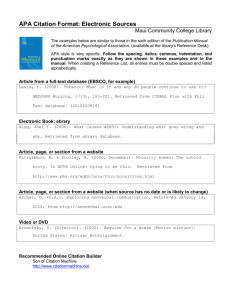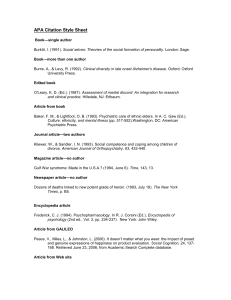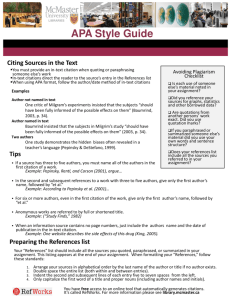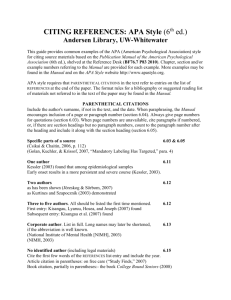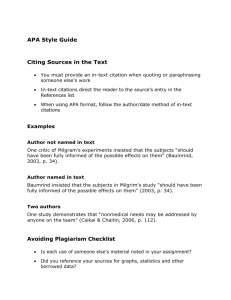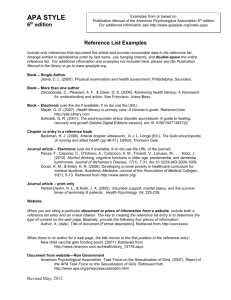APA
advertisement
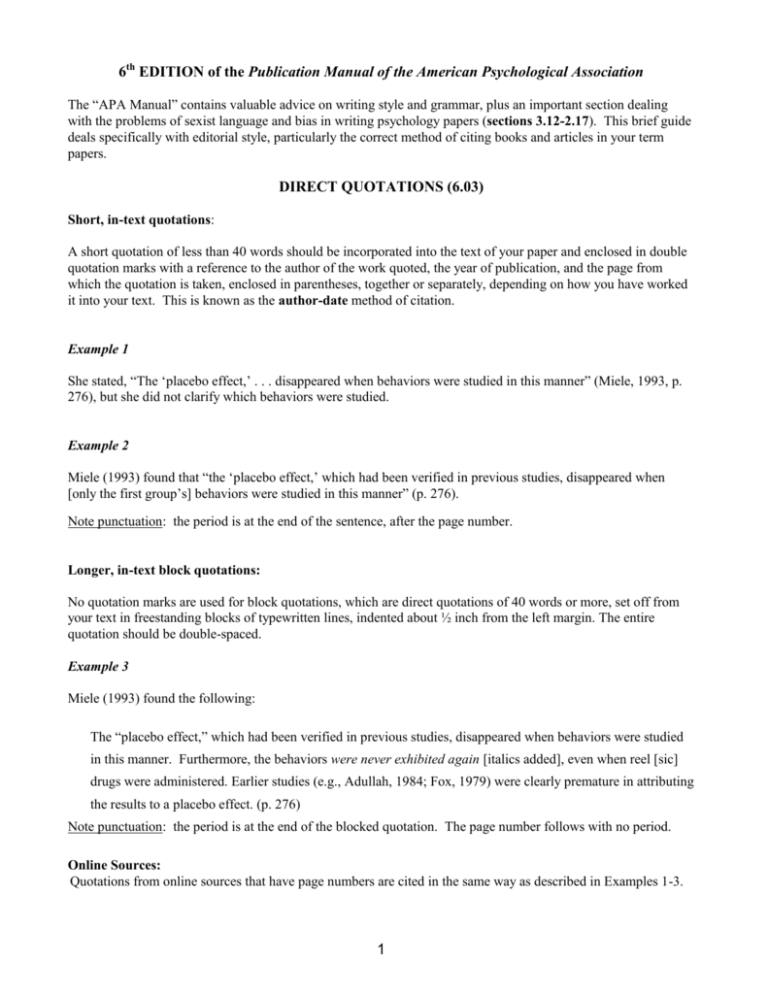
6th EDITION of the Publication Manual of the American Psychological Association The “APA Manual” contains valuable advice on writing style and grammar, plus an important section dealing with the problems of sexist language and bias in writing psychology papers (sections 3.12-2.17). This brief guide deals specifically with editorial style, particularly the correct method of citing books and articles in your term papers. DIRECT QUOTATIONS (6.03) Short, in-text quotations: A short quotation of less than 40 words should be incorporated into the text of your paper and enclosed in double quotation marks with a reference to the author of the work quoted, the year of publication, and the page from which the quotation is taken, enclosed in parentheses, together or separately, depending on how you have worked it into your text. This is known as the author-date method of citation. Example 1 She stated, “The „placebo effect,‟ . . . disappeared when behaviors were studied in this manner” (Miele, 1993, p. 276), but she did not clarify which behaviors were studied. Example 2 Miele (1993) found that “the „placebo effect,‟ which had been verified in previous studies, disappeared when [only the first group‟s] behaviors were studied in this manner” (p. 276). Note punctuation: the period is at the end of the sentence, after the page number. Longer, in-text block quotations: No quotation marks are used for block quotations, which are direct quotations of 40 words or more, set off from your text in freestanding blocks of typewritten lines, indented about ½ inch from the left margin. The entire quotation should be double-spaced. Example 3 Miele (1993) found the following: The “placebo effect,” which had been verified in previous studies, disappeared when behaviors were studied in this manner. Furthermore, the behaviors were never exhibited again [italics added], even when reel [sic] drugs were administered. Earlier studies (e.g., Adullah, 1984; Fox, 1979) were clearly premature in attributing the results to a placebo effect. (p. 276) Note punctuation: the period is at the end of the blocked quotation. The page number follows with no period. Online Sources: Quotations from online sources that have page numbers are cited in the same way as described in Examples 1-3. 1 Direct Quotations from Online Material Without Pagination (6.05) Example 1 (Paragraph numbers) Use for direct quotation or paraphrasing from electronic sources that do not provide page numbers but do provide paragraph numbers. Use the paragraph number in place of the page number, preceded by the abbreviation para. As Myers (2000) aptly phrased it, “positive emotions are both an end–better to live fulfilled, with joy [and other positive emotions]–and a means to a more caring and healthy society” (para. 5). Example 2 (Headings) Use for direct quotation or paraphrasing when there are neither paragraph nor page numbers, but headings such as Introduction, Method, Results, Discussion, Conclusion are present. Cite the heading and the paragraph following the heading. This will direct the reader to the appropriate section. Beutler concludes that our existing managed care organizations, and the ways in which we approach treatments, are shortsighted (Beutler, 2000, Conclusion section, para. 1). Example 3 (Short headings) Many web sites provide no page or paragraph numbers and the headings may be very long and unwieldy to cite in full. In these cases use a short portion of the title enclosed in quotation marks: “Empirical studies have found mixed results on the efficacy of labels in educating consumers” (Golan, Kuchler, & Krissof, 2007, “Mandatory Labeling Has Targeted, “ para. 4). (Note: the full title was “Mandatory Labeling Has Targeted Information Gaps and Social Objectives.”) Personal Communications (e.g., e-mail, letters, memos, conversations, interviews) (6.20) Personal communications, because they contain no recoverable data, are not included in reference lists. Cite these sources in the body of the text only. T.K. Lutes (personal communication, April 18, 2001) (V.G. Nguyen, personal communication, September 28, 1998) Personal communications that are recoverable should be referenced as archival material (7.10). 2 Citing References in Text (indirect quotations, paraphrasing; 6.04, 6.11 - 6.16) When you cite an author‟s work indirectly (that is, when you do not quote from it exactly but paraphrase or refer, in your own words, to that author‟s ideas, research, conclusions, etc.), you must briefly identify your source. APA encourages the use of page numbers for indirect quotations when it will help the reader find the relevant section in a long text. Each reference that is cited in the body of your paper must have a corresponding entry in your reference list at the end of your paper, and each reference at the end of your paper must have been cited in text. One Work By One Author (6.11) Example 1 At an appropriate point in your text, simply insert between parentheses the last name of the author of the source to which you are referring and the date of its publication, separating the two by a comma and a space: A study of reaction times (Rogers, 1994) found that Example 2 If the author‟s name has been worked into your text, only the date is needed in the parentheses: Rogers (1994) compared reaction times Example 3 If the author‟s name and date appear within your text, no parenthetical information is needed: In 1994, Rogers compared reaction times. . . Example 4 Citing the same author a second time: Within a paragraph, if you work the author‟s name into the body of your text more than once, and as long as the study cannot be confused with another cited study, it is not necessary to include the year in a subsequent reference: In a study of reaction times, Rogers (1994) described the method...Rogers also found... Note: When you use a parenthetical citation (Example 1) always include the year. One Work By Multiple Authors (6.12 - 6.16; also see Table 6.1, p. 177 for examples) Example: 2 Authors When a work has two authors, always cite both surnames every time the reference occurs in your text. Smith and Jones (2008) found that In a 2008 study it was shown that consumers were unmoved by the advertisement (Smith & Jones). Note: when the citation is non-parenthetical the word and is written out in full; the parenthetical citation uses the ampersand (&) sign. 3 Example: 3-5 Authors If there are three to five authors, cite all authors the first time. In subsequent references, cite only the surname of the first author followed by “et al.” and the year if it is the first citation of the reference within a paragraph. Wasserstein, Zappulla, Rosen, Gertman, and Rock (1994) found that the data are related. [First citation] Wasserstein et al. (1994) found... [Subsequent citation per paragraph thereafter] [Omit the year from subsequent non-parenthetical citations after the first citation within a paragraph; include date for parenthetical citations.] Example: 6 or More Authors When a work has six or more authors, cite only the surname of the first author followed by et al. Groups As Authors (6.13) The name of a group author is usually spelled out each time it appears in your text. The names of some authors are spelled out in the first citation and abbreviated thereafter. Use your judgement. The reader of your paper should be able to locate it and the complete citation of the work in the reference list at the end of your paper. Example Entry in reference list: National Institute of Mental Health. (2009). First text citation: (National Institute of Mental Health [NIMH], 2009) Subsequent text citation: (NIMH, 2009) Authors With Same Surname (6.14) When a publication contains two or more primary authors with the same surname, include the first author‟s initials in all text citations, even when the year of publication is different. Example 1 R.D. Luce (1954) and P.A. Luce (1986) also found Example 2 J.M. Goldberg and Nerf (1961) and M.E. Goldberg and Wurtz (1972) studied Specific Parts of a Source (6.19) In addition to the author and the date, indicate the page, chapter, figure and table, if necessary, at the appropriate point in your text. Page numbers should always be given for direct quotations. Example 1 (Cheek & Buss, 1981, p. 332) Example 2 (Shimamura, 1989, Chapter 3) Example 3 (Smith, 2011, pp. 9-10) Note that the page number is abbreviated, but not the chapter in text citations. 4 No Author (6.15) When a work has no author, cite a few words of the reference list entry–usually the title–and the year. Put double quotation marks around the title of an article, chapter or web page; use italics for the title name of a journal, a book, a brochure or a report. Example 1 The marketing mix, or the four P‟s of marketing (“The Marketing Mix,” 2009), shows that (Web site) Example 2 The book College Bound Seniors (2008) shows that many first-year students (Book) Use the term “Anonymous” only when a work designates the author as Anonymous: Example (Anonymous, 2008) Secondary Sources (6.17) A secondary source is the use of a quote within a quote. Use these sparingly, always trying to find the original source. List only the secondary source (the work you read) in your reference list. The original source is named only in the text. For example, if Smith is quoted in Finch, and you did not read the work by Smith, list the Finch source in the reference list. In the text, use the following citation: Example Smith‟s findings (as cited in Finch, 2005) showed that “no evidence was found . . .” Images Cite images (photographs, paintings, charts, maps, etc.) in the text in the same way you cite other sources: author, creator, or artist and the date. If no author information is available, use the title as in 6.15. 5 REFERENCE LIST (7.01- 7.11 and A7.01-A7.07) Important things to keep in mind: Entries are in alphabetical order by authors‟ last name (or title when a work has no author). The reference list must be double-spaced. Examples here are single-spaced to save space. Entries should have a hanging indent (as used below). For electronic sources include the same citation elements (author, title, date, etc.) in the same order as you would for a print source, and add as much electronic retrieval information to locate the sources you cited. Direct readers as closely as possible to the source used and when in doubt follow the principle of providing more information rather than less. Issue numbers: if each issue of a journal begins on page 1, include the journal volume number and issue number Retrieval dates: do not include retrieval dates unless the material is likely to change over time (wikis or changeable content from the open web). Legal materials are cited in accordance with The Blue Book: A Uniform System of Citation (18th ed., 2005). An abbreviated version of The Blue Book can be found in Appendix A of the APA Manual. DOIs: APA now requires the use of a DOI (digital object identifier) whenever it is available, regardless of whether you accessed the article in print or online. The DOI allows a reader to link directly to an article via the publisher‟s web site. Publishers who provide this information usually place it prominently on the first page of the article; databases like PsycInfo, Business Source Premier, etc., will also place it within the full record of each article (on the abstract page). If no DOI has been assigned to an online work, provide the home page URL of the journal, book or report publisher. You will likely have to look up the name of the journal in Google to find the publisher‟s home page. While APA indicates that, in general, one needs not include database information, your professor may require this information. Examples of both versions are provided below. Journal Article with DOI (7.01, 1) PRINT or ONLINE Mellers, B. A. (2000). Choice and the relative pleasure of consequences. Psychological Bulletin, 126(6), 910-924. doi:10.1037/0033-2909.126.6.910 Journal Article with no DOI (7.01, 3) PRINT: Larson, L. (2009). E-reading and e-responding: New tools for the next generation of readers. Journal of Adolescent & Adult Literacy, 53, 255-258. ONLINE with publisher‟s URL (APA preferred style): Larson, L. (2009). E-reading and e-responding: New tools for the next generation of readers. Journal of Adolescent & Adult Literacy, 53, 255-258. Retrieved from http://www.reading.org/General/ Publications/ Journals/JAAL.aspx ONLINE with database information (where article was actually retrieved): Larson, L. (2009). E-reading and e-responding: New tools for the next generation of readers. Journal of Adolescent & Adult Literacy, 53, 255-258. Retrieved from Academic Search Premier database. While APA suggests that you not provide database information and instead provide the publisher‟s home page URL as described above, APA also recommends that you “add as much electronic retrieval information as needed for others to locate the sources cited” (p. 187). While the second example (ONLINE with publisher‟s URL) is APA‟s preferred style, the article was not “retrieved” there, nor is it possible to retrieve it there without a subscription or paying. The article was retrieved in full-text from the database cited in the third example (ONLINE with database information). Confirm with your professors which format to use. 6 Magazine Article, two authors (7.01, 7) PRINT: Kandel, E. R., & Squire, L. R. (2000, November 10). Neuroscience: Breaking down scientific barriers to the study of brain and mind. Science, 290, 1113-1120. ONLINE (with publisher‟s URL): Kandel, E. R., & Squire, L. R. (2000, November 10). Neuroscience: Breaking down scientific barriers to the study of brain and mind. Science, 290, 1113-1120. Retrieved from http://www.sciencemag.org/ magazine.dtl ONLINE (with database information): Kandel, E. R., & Squire, L. R. (2000, November 10). Neuroscience: Breaking down scientific barriers to the study of brain and mind. Science, 290, 1113-1120. Retrieved from Academic Search Premier database. More than seven (7) authors (7.01, 2) If there are seven authors or fewer, spell out all authors‟ names in the reference list; for eight or more authors, use the following format [list first six authors . . . last author]: Gilbert, D. G., McClernon, J. F., Rabinovich, N., Sugai, C., Plath, L. C., Asgaard, G., . . . Borros, N. (2004). Title of article. Title of Periodical, xx, pp-pp. doi:xxx.xxxxxx.xxxx Newspaper Article (7.01, 10) PRINT: Schwartz, J. (1993, September 30). Obesity affects economic, social status. The Washington Post, pp. A1, A4. ONLINE: Hilts, P. J. (1999, February 16). In forecasting their emotions, most people flunk out. The New York Times. Retrieved from http://www.nytimes.com If an article appears on discontinuous pages, give all page numbers and separate the numbers with a comma. (e.g., pp. B1, B3, B5-B7; use “pp.” for multiple pages; “p.” for a single page). Book (7.02, 18-21) PRINT: Beck, C. A. J., & Sales, B. D. (2001). Family mediation: Facts, myths, and future prospects. Washington, DC: American Psychological Association. ONLINE: Carey, J. W. (2009). Communication as culture: Essays on media and society. New York, NY: Routledge. Retrieved from http://lib.myilibrary.com When an e-book is subscription-based, provide only the publisher/company home page URL and not the exact item record URL. ONLINE, Open-Access, corporate author: World Bank. (2006). Information and communications for development: Global trends and policies. Retrieved from http://books.google.ca/books 7 Article or Chapter in an Edited Book (7.02, 26) PRINT: Bjork, R. A. (1989). Retrieval inhibition as an adaptive mechanism in human memory. In H. L. Roediger III & F. I. M. Craik (Eds.), Varieties of memory & consciousness (pp. 309-330). Hillsdale, NJ: Erlbaum. ONLINE: Deuze, M. (2009). Journalism, citizenship, and digital culture. In P. Zizi (Ed.), Journalism and citizenship (pp. 15-28). Taylor & Francis e-Library. Retrieved from http://www.eblib.com Book Review (7.06, 45) PRINT: Smith, A. B. (2002). Mapping the text. [Review of the book Geography of the book by M. J. Sullivan & V. Daigle]. Geography Canada, 90(1), 301. ONLINE: Schatz, B. R. (2000, November 17). Learning by text or context? [Review of the book The social life of information by J. S. Brown & P. Duguid]. Science, 290, 1304. doi:10.1126/science.290.5495.1304 Corporate Author, brochure PRINT: Research and Training Center on Independent Living. (1993). Guidelines for reporting and writing about people with disabilities (4th ed.) [Brochure]. Lawrence, KS: Author. Entire Encyclopaedia or Dictionary (7.02, 27) PRINT: Sadie, S. (Ed.). (1980). The new Grove dictionary of music and musicians (6th ed., Vols. 1-20). London: Macmillan. Entry in an reference work (7.02, 30) PRINT: Bergman, P. G. (1993). Relativity. In The new encyclopaedia Britannica (15th ed., Vol. 26, pp. 501-508). Chicago: Encyclopaedia Britannica. Autism. (1993). In Merriam-Webster’s Collegiate Dictionary (10th ed.). Springfield, MA: MerriamWebster. ONLINE: Autism. (n.d.). In Merriam-Webster’s Collegiate Dictionary (10th ed.). Retrieved from http://www.mw.com/dictionary/autism Examples shown with and without a date. 8 Stand-alone Web Page GVU's 8th WWW user survey. (n.d.). Retrieved November 10, 2008 from http://www.cc.gatech.edu/gvu/ usersurveys/survey1997-10 If the author of a document is not identified, begin the reference with the title of the document. The abbreviation n.d. is used when no date of publication is provided. Date of retrieval is included because the content is likely to change (APA, p. 192). Steintrager, M. O. (Ed.). (n.d.). Healthy-eating tips and light party recipes for the holidays. Retrieved December 10, 2009 from http://www.epicurious.com/articlesguides/healthy/news/holidayhealthyeatingtips This website had an editor, but no date. The title is not italicized. Note on italics: use italics for book, brochure, report or document titles; the title or name of a web site is not italicized. ERIC Document Brewster, C., & Railsback, J. (2002). Full-day kindergarten: Exploring an option for extended learning. Retrieved from ERIC database. (ED472733) James, N., Schmitz, G. H., Canning, A., & Johnston, R. (2007). Perspectives on the first year university experience. Retrieved from http://eric.ed.gov A number of examples exist for citing ERIC documents. These are two versions. Documents available from an organization, university or departmental web site (7.03, 34) Chou, L., McClintock, R., Moretti, F., & Nix, D. H. (1993). Technology and education: New wine in new bottles: Choosing pasts and imagining educational futures. Retrieved from Columbia University, Institute for Learning Technologies website: http://www.ilt.columbia.edu/publications/papers/ newwine1.html If a document that presents an organization‟s philosophy, position or policy is contained within a large and complex web site, identify the host organization and the relevant program or department before giving the URL for the document itself. Thesis or Dissertation retrieved from a subscription database (7.05, 40) Buckner, A. L. (2007). Appetite awareness training in the prevention of eating disorders (Doctoral dissertation). Retrieved from ProQuest Dissertations and Theses database. (AAT 3273686) Thesis or Dissertation retrieved from Theses Canada Portal or university web site (7.05, 42) Roth, D. H. (2004). Adult reflections on childhood verbal abuse (Master‟s thesis, University of Saskatchewan). Retreived from http://www.collectionscanada.ca/obj/s4/f2/dsk3/SSU/TC-SSU-07272004163726.pdf Wiki Market research. (2007, November 20). In Wikipedia, The Free Encyclopedia. Retrieved November 28, 2011, from http://en.wikipedia.org/w/index.php?title=Marketing_research&oldid=173254885 Note: a retrieval date is included because Wiki articles are updated constantly and the content is likely to change. 9 Blog (Weblog) (7.11, 76) Geist, M. (2007, November 27). Universal Music CEO on technology [Web log post]. Retrieved from http://www. michaelgeist.ca/content/view/2413/196 Note: no retrieval date is included because the posting is archival and should not change. YouTube (Video post) (7.11, 77) Norton, R. (2006, November 4). How to train a cat to operate a light switch [Video file]. Retrieved from http://www.youtube.com/watch?v=Vja83KLQXZs Note: no retrieval date is included because a video is static and should not change. Online Images: APA provides few instructions or examples on citing images. Sections 5.20-5.30 (Figures), 7.07 (Audiovisual Media) and 7.10 (Archival Documents and Collections) provide additional examples. These examples provide the basic details necessary for a Works Cited list. Miflin, G. (2008). The royal family [Image]. Retrieved from http://www.gates.edu.uk/art/family/objects/o407.html Author. Date. Title of work [Description of form]. Retrieved from URL. Boy_Wonder. (2009, December 7). The Ginch [Image]. Retrieved December 10, 2009 from http://www.flickr. com/ photos/joel_r/ 4167072565/ Screen name. Date. Title of work [description of form]. Retrieved Date from URL. (Date of retrieval is included because the content is likely to change (APA, p. 192). Banff National Park [Image]. (n.d.). Retrieved December 10, 2009 from http://www.wildlifearchives.com/ images/banff- moraine-lake.jpg No author/creator, no date. Include: Title of work [Description of form]. Retrieved Date from URL. (Date of retrieval is included because the content is likely to change (APA, p. 192). Canadian Government Documents For general information on citing Canadian Government Documents please see the MSVU library website at: http://www.msvu.ca/en/home/library/research/citationrefworks/govcite.aspx Updated October 2012 10

